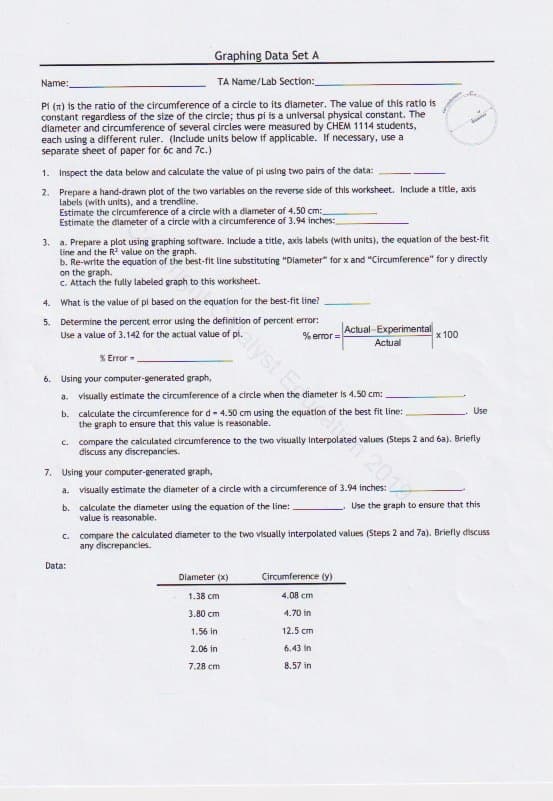PI (n) is the ratio of the circumference of a circle to its diameter. The value of this ratio is constant regardless of the size of the circle; thus pi is a universal physical constant. The diameter and circumference of several circles were measured by CHEM 1114 students, each using a different ruler. (Include units below if applicable. If necessary, use a separate sheet of paper for 6c and 7c.) 1. Inspect the data below and calculate the value of pi using two pairs of the data: 2. Prepare a hand-drawn plot of the two variables on the reverse side of this worksheet. Include a title, axis labels (with units), and a trendline. Estimate the circumference of a circle with a diameter of 4.50 cm: Estimate the diameter of a circle with a circumference of 3.94 inches 3. a. Prepare a plot using graphing software. Include a title, axis labels (with units), the equation of the best-fit line and the R value on the graph. b. Re-write the equation of the best-fit line substituting "Diameter" for x and "Circumference" for y directly on the graph. C. Attach the fully labeled graph to this worksheet. 4. What is the value of pl based on the equation for the best-fit line? 5. Determine the percent error using the definition of percent error: Use a value of 3.142 for the actual value of pl. Actual-Experimental Actual % error= x 100 s Eror - 6. Using your computer-generated graph, a. visally estimate the circumference of a circle when the diameter is 4.50 cm: , b. calculate the circumference ford-4.50 cm using the equation of the best fit line: Use the graph to ensure that this value is reasonable. c compare the calculated circumference to the two visually Interpolated values (Steps 2 and 6a). Briefly discuss any discrepancies. 7. Using your computer-generated graph, a. visually estimate the diameter of a circle with a circumference of 3.94 inches: b. calculate the diameter using the equation of the line: Use the graph to ensure that this value is reasonable. c. compare the calculated diameter to the two visually interpolated values (Steps 2 and 7a). Briefly discuss any discrepancies. Data: Circumference (y) TT Diameter (x) 1.38 cm 4.08 cm 3.80 cm 4.70 in 1.56 in 12.5 cm 2.06 in 6.43 in 7.28 cm 8.57 in
Optimization
Optimization comes from the same root as "optimal". "Optimal" means the highest. When you do the optimization process, that is when you are "making it best" to maximize everything and to achieve optimal results, a set of parameters is the base for the selection of the best element for a given system.
Integration
Integration means to sum the things. In mathematics, it is the branch of Calculus which is used to find the area under the curve. The operation subtraction is the inverse of addition, division is the inverse of multiplication. In the same way, integration and differentiation are inverse operators. Differential equations give a relation between a function and its derivative.
Application of Integration
In mathematics, the process of integration is used to compute complex area related problems. With the application of integration, solving area related problems, whether they are a curve, or a curve between lines, can be done easily.
Volume
In mathematics, we describe the term volume as a quantity that can express the total space that an object occupies at any point in time. Usually, volumes can only be calculated for 3-dimensional objects. By 3-dimensional or 3D objects, we mean objects that have length, breadth, and height (or depth).
Area
Area refers to the amount of space a figure encloses and the number of square units that cover a shape. It is two-dimensional and is measured in square units.

Trending now
This is a popular solution!
Step by step
Solved in 7 steps with 1 images









